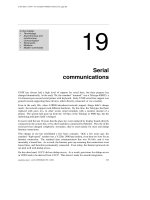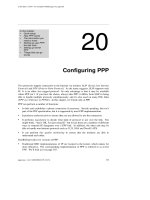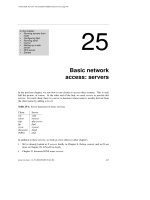Tài liệu Chapter VIII Dielectrics ppt
Bạn đang xem bản rút gọn của tài liệu. Xem và tải ngay bản đầy đủ của tài liệu tại đây (218.21 KB, 15 trang )
1/29/2008 1
GENERAL PHYSICS II
Electromagnetism
&
Thermal Physics
1/29/2008 2
Chapter VIII
Dielectrics
§1. Induced charges and polarization of dielectrics
§2. Molecular model of induced charges
§3. Piezoelectric effect
1/29/2008 3
We have known how can describe the electric field in vacuum.
How is the electric field in a matter environment?
In this chapter we consider the case that the environment is a
nonconducting material
Recall that in a conducting body (conductor) the charges move freely in
respond to an electric field, but in nonconducting bodies the charges can
not move freely.
Nonconducting bodies are called dielectrics or insulators.
1/29/2008 4
§1. Induced charge and polarization of dielectrics:
1.1 Effects with dielectrics in an electric field:
One might at first believe that there should be no effect with dielectrics in
respond to an electric field. But Faraday discovered that this was not so!
A simple experiment is shown in the picture:
- Two conducting plates with magnitude of charge Q.
- The electrometer that measures
the potential difference V between two
conducting plates
+Q -Q
Experiment shows that the potential
difference V between plates decreases
when we insert an uncharged sheet of
dielectric (glass, paraffin, polystyrene,…).
Note that the electrometer measures only
potential difference, there is no current
through it. It means that the charge Q is
constant.
V
1/29/2008 5
1.1 Induced charges and polarization:
Why the potential difference between two conducting plates decreases?
In an dielectric there are not free charges, electrons are not free to flow
from one atom (or molecule) to another. The electric asymmetry of atoms
(molecules) leads to the existence of electric dipoles. These dipoles are
randomly aligned, therefore the net electric field inside the electric is zero
(pic. a).
When the dielectric is placed between charged plates of magnitude Q,
surface charge density σ
0
, the electric field E
0
between plates exrets
torques on the dipoles. These torques tend to align the dipoles with the
field (pic. b).
By this effect there exits a net charge density σ
i
induced in the surfaces of
the dielectric (pic. c).
a)
b) c)
1/29/2008 6
2.3 The dielectric constant:
The induced charges on the surfaces of the dielectric creates an
induced electric field E
i .
The direction of E
i
is opposite to the electric field
E
0
. Therefore, the net electric field inside the dielectric is
We define the dielectric constant
+σ
0 -σ
0
-σ
i
+σ
i
+
+
-
-
-
-
+
+
E
0
E
i
1 < k < ∞
perfect dielectric
(vacuum)
perfect conductor
The potential difference between the plates is smaller by a factor of k.









